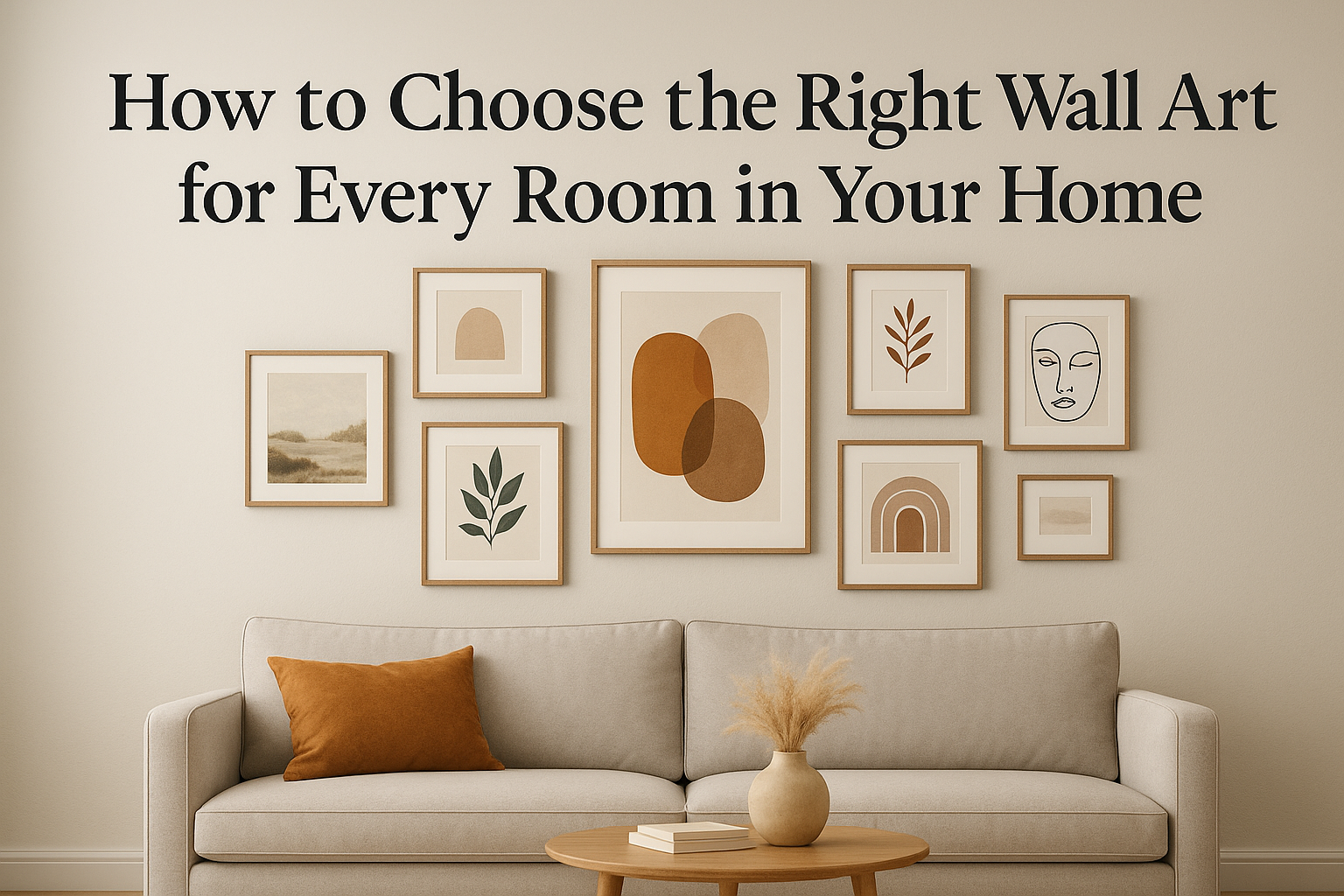Wall art is often the finishing touch that transforms a house into a home. It adds personality, depth, and a sense of completion to any space. But selecting the right pieces — in the right size, style, and placement — can feel overwhelming.
This guide will walk you through how to choose wall art that complements your space, enhances your decor, and reflects your personality.
Why Wall Art Matters
Art isn’t just decoration — it’s expression. Here’s what well-chosen wall art can do:
- Tie together a room’s color palette
- Add texture or dimension to flat spaces
- Create a focal point in a room
- Reflect your taste, culture, or memories
- Make the space feel more “finished”
Whether it’s a statement canvas or a subtle print, the right art elevates the entire room.
1. Consider the Room’s Function First
Each room serves a purpose — and your wall art should reflect that.
Living Room
This is a space for gathering, so choose art that’s bold or conversational.
- Large statement pieces above the sofa
- Gallery walls with a mix of sizes and styles
- Art that matches your color palette or adds contrast
Bedroom
Your bedroom is your retreat. Aim for calming, intimate, or meaningful pieces.
- Soft abstracts, nature scenes, or black and white photography
- Art above the bed or on side walls
- Framed poems or quotes
Kitchen
Keep it playful or cozy in the kitchen.
- Food-inspired prints or vintage posters
- Small frames on open shelves
- Chalkboard art or handwritten recipes
Bathroom
Think spa-like, minimalist, or whimsical.
- Small framed prints or simple line art
- Beach, nature, or botanical themes
- Humorous quotes if you want something light
Entryway
First impressions matter!
- Statement mirrors or large artwork
- Maps, family quotes, or abstract designs
- Gallery walls showcasing travel or family photos
2. Match Art Style with Room Style
Your wall art should enhance your room’s existing aesthetic.
- Modern room? Go for bold abstract art or geometric prints.
- Farmhouse or rustic? Try wood-framed art, vintage landscapes, or botanical sketches.
- Boho style? Use macramé, eclectic prints, or travel photography.
- Minimalist? Stick with monochromatic or line drawings.
- Glam or luxe? Opt for metallic accents, oversized photography, or high-contrast black and white.
Mixing styles is okay — just make sure there’s a unifying color or theme.
3. Choose the Right Size
One of the most common wall art mistakes is using pieces that are too small.
Here’s a quick sizing guide:
- Over a sofa or bed: Artwork should be about 2/3 the width of the furniture
- Over a console or mantel: Go slightly narrower, or hang a series of 2–3 pieces
- On a blank wall: Use large pieces, gallery groupings, or create a vertical layout for tall spaces
Tip: Use paper templates or painter’s tape to map out the size before you hang anything.
4. Think About Framing
Framing can dramatically change how art looks.
- Matte black or white frames = modern and clean
- Wood frames = warm and organic
- Metallic frames = glamorous and sophisticated
- No frame (canvas) = casual and contemporary
Framing should complement both the art and the rest of the room.
5. Create a Gallery Wall
Gallery walls are a great way to showcase multiple pieces in a curated way.
- Choose a theme (e.g. black and white photos, travel art, family moments)
- Use consistent framing for a clean look, or mix for an eclectic vibe
- Lay the arrangement out on the floor first to test spacing
- Start with the centerpiece and work outwards
This works especially well in living rooms, hallways, and staircases.
6. Don’t Be Afraid of Color
Wall art is a perfect way to inject color into a neutral room.
- Pick one or two bold hues from the artwork and echo them in pillows, rugs, or accessories
- Use art to complement or contrast the wall color
- Abstract art with bright tones can modernize traditional spaces
If you’re color-shy, try muted versions like navy, burgundy, forest green, or blush.
7. Use Unexpected Spaces
Art isn’t only for eye-level walls.
- Hang small pieces above door frames
- Place art on shelves or leaned against the wall
- Use artwork in built-in bookcases, bathrooms, or even closets
- Display art in the kitchen above countertops or breakfast nooks
These touches make your home feel intentional and full of personality.
8. Rotate Art Seasonally or When You Need Change
One of the best things about wall art is how easily it can be swapped.
- Rotate artwork for seasonal moods (e.g. light florals in spring, warm tones in autumn)
- Create a “gallery shelf” to lean and swap out pieces effortlessly
- Update artwork to reflect new interests or travels
It keeps your space feeling fresh without major redecorating.
9. Add Dimension with Non-Traditional Art
Not all wall art has to be prints or paintings.
- Tapestries
- Wall baskets
- 3D panels or sculptures
- Macramé and fiber art
- Shadow boxes with mementos
Mixing textures adds depth and keeps your walls interesting.
Final Thoughts: Art That Feels Like You
At the end of the day, wall art should be something you love to look at. It doesn’t need to be expensive or “perfect.” The best art reflects your story — your travels, your values, your style.
Whether it’s a hand-painted canvas, a photo you took on vacation, or a thrifted treasure, let your walls speak your language.
